Despite being equally as impressive and just as beautiful as Ayers Rock (some say more beautiful), The Olgas are the less-visited geological formation at Uluru-Kata Tjuta National Park in central Australia. Located just 27 miles from Ayers Rock, the Olgas are a series of rounded domes that poke their heads above the sand dunes covering the valley floor – thus their Anangu name of Kata Tjuta, meaning “many heads.” Determined not to miss this step-child attraction, I boarded a shuttle bus early this morning, bound for the hour and a half Olga Gorge Walk.

I stepped off the bus into the coldest temperatures yet and was immediately chilled to the bone. With my head lowered against buffeting winds, I made my way down the canyon passageway, Kata’s Tjuta’s giant red “heads” held high and and unfazed by the weather. This was a landscape reminiscent of Ayers Rock in some ways – the red rock, the desert floor, the scrub landscape, and the water catchments carved out of rock – but in other ways Kata Tjuta is a world apart. Ayers Rock is composed of iron-rich feldspar sands that were compressed by geologic forces over time into Arkose sandstone. The formations at Kata Tjuta are composed of conglomerate, a mix of granite and basalt pebbles, cobbles and boulders that have been cemented together by mud and sand over the eons. From a distance the two formations look similar. Up close there is no comparison, yet the source of these two geologic formations is identical.

About 550 million years ago the Petermann Mountain ranges were uplifted to the west of the current day site of the Kata Tjuta. These bare mountains eroded easily. Huge amounts of sediment washed away when it rained and formed alluvial fans adjacent to the ranges. One fan was mainly composed of sand; the other fan contained mainly water-smoothed rocks. Both fans became at least 2 miles thick. By about 500 million years ago a shallow sea had covered the region. The alluvial fans were gradually covered by sand and mud and the remains of sea creatures. The overlying sediment deposits compressed and cemented the sand into Arkose sandstone and the coarse gravels into conglomerate. When the seas receded (300-400 million years ago), the rocks were folded and fractured, raising the region above sea level and thrusting the two monoliths high above the bedrock. Erosion has since worked its magic, sculpting the rocks into smooth rounded features, while the valley continued to fill with river sands and swamp deposits. During the past 500,000 years the climate became drier and a blanket of wind blown sand covered the valley floor, thus today we see only the tips of the two rock formations, with more than two thirds of their bulk buried beneath the desert sands.
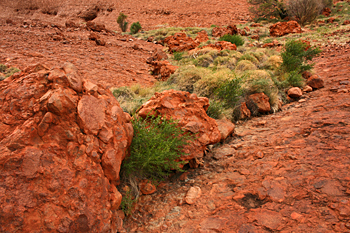
The Olga Gorge Walk followed a path carved out of the conglomerate and smoothed by countless footsteps. Between the towering red walls and the path, huge boulders littered the ground, as if spit out by the canyon in its fury at being invaded. Prickly blue-grey grass hummocks interlaced their communal roots, stabilizing and preventing erosion of the sand dunes. Even in this harsh landscape there was beauty – small purple flowers crouched close to the rocky ground and delicate orchid-like blooms hid behind the leaves of a flowering tree.
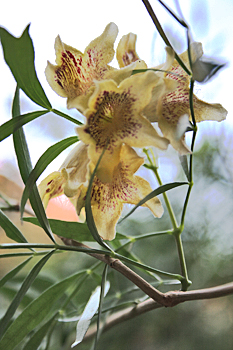


Here and there depressions in the rock held pools of crystal clear rainwater that reflected the V-shape canyon walls in the distance. The walk ended at a viewing platform – the uninitiated are not allowed to go further into the canyon, as it is considered a sacred site by the Anangu.
There were only three of us on the walk into the gorge – Richard and Judith Evans from Bendigo, Australia had kept me company and we discovered we were kindred spirits when they, too, were able to see the green light emanating from the top of Kata Tjuta. Walking out of the gorge we passed a tour group of perhaps 20 people just heading into the canyon. I was grateful not to have been in the company of so many people because it certainly would have diluted the spiritual experience to be in the company of so many people.

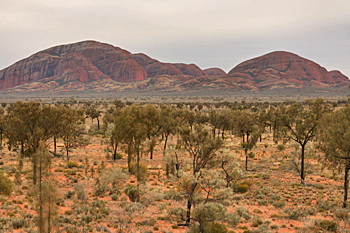
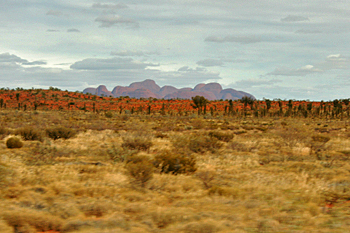
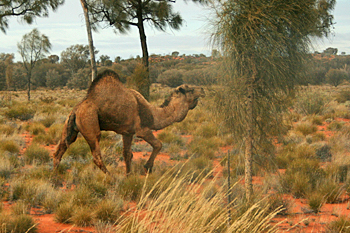
During the bus ride back to the hotel, KataTjuta changed colors like a kaleidoscope, alternating between red and purple as our direction changed with respect to the rocks. Focused on the panorama it offered, we were startled when our driver slammed on the brakes – two feral camels, frothing at the mouth, were plodding across the desert sands in search of mates. There are apparently thousands of these wild camels roaming the interior of the country, leftovers from pioneers who used them as pack animals. In fact, there are so many of them that the tour company does not offer a sunset tour of Kata Tjuta because the road to it travels through remote country and driving after dark can be dangerous. I believe it – I don’t want to think about the damage that could be done if a car hit a camel!
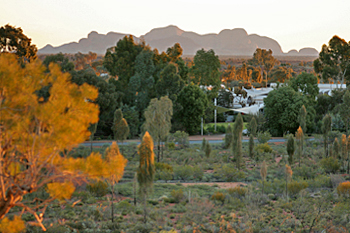
I ended the day the same way I began my visit to Uluru-Kata Tjuta – I climbed the overlook at the top of a large sand dune in the center of the resort and watched the sunset cast the distant Kata Tjuta range into a deep purple hue as it reflected the day’s final rays.

Hello Barbara! We’re Carmen and Ruben (Spain), we meet you in Ayers Rock, Australia. I have read your web site and the photographs are amazing. Thanks a lot to think about us to send us an email. We hope you’re ok and your travel will be right. We arrive to our city on June 30th. We’re working again and put all the furniture in our house.
We’ll check your web sometimes.
Warm Regards.
Carmen and Ruben.
Dear Barb,
It is such a pretty place with an amazing colors. You are so lucky to have the opportunity to see the different part of the world and I am so happy to be able to ravel with you through your online travel journal.
Warmest regards,
Wayan.
Dear Barb,
Thanks for presenting your trip online, it is fun following you around. Also, thanks for the birthday card. THe orb is way-cool! Spirits abound. Our CD comes out tomorrow and we are having our CD release party on my birthday. Have fun and be safe in Africa.
R